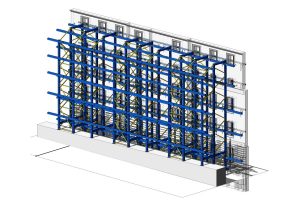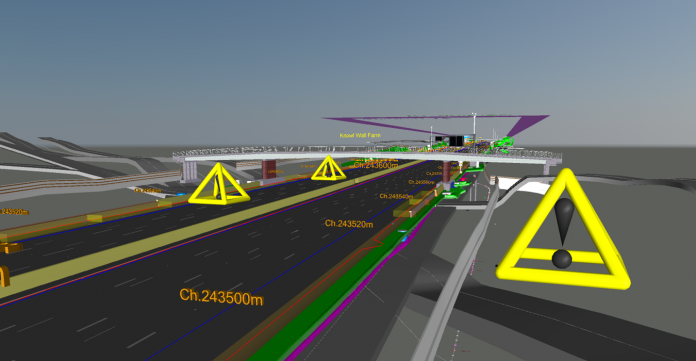Is BIM/virtual simulation and modelling emerging as a valuable tool for mitigating physical risk and promoting safety on site? Kier’s Andy Radley takes a look
The recent release of PAS 1192-6 has certainly sharpened the focus of the Level 2 BIM community when it comes to the potential use of BIM to anticipate and mitigate risk. There has always been plenty of discussion around this concept; however, there’s little evidence to support its day-to-day application and use in the public domain.
It appears though that we may be seeing a change in the way BIM is viewed in regard to health and safety, with the creation of a new suite of standards documents focused on integrating safety regulations into the “virtual” modelling and simulation of assets reportedly well received and even assisted by the Health & Safety Executive.
Those familiar with the Construction (Design and Management) Regulations (CDM) will know they are supported by six fundamental pillars, all of which have the potential to benefit from the virtual construction process supported by complementary technologies:
1. Site layout, boundaries and access
BIM models can clearly anticipate, explain and resolve potential issues. The challenge here is ensuring that consultants and contractors share models so a coordinated solution can be agreed.
2. Highlight potential hazards
BIM models can be used in advance to effectively plan or investigate safety equipment provision. Additionally, it can anticipate and plan appropriate training requirements.
3. Explain sequences and procedures
Using visual task sheets, sequence animations and temporary works models can demystify complexities on site.
4. Emergency planning
BIM models can be used to explain evacuation routes and play out any other scenarios.
5. Site induction
A BIM model can be used and animated to explain the evolving site layout, which is typically more engaging than the traditional 2D, marked-up CAD drawings. This approach can be also shown to transition language barriers.
6. Demonstrate and manage change
Iterations of BIM models can be compared against one another and easily demonstrate change that result in changes to the CDM strategy.
There is clear evidence showing that these activities can be supported using a virtual world. However, the reality is that they rely largely on geometry and collaboration, rather than the creation of structured data and other non-graphical formats recognised as BIM.
Kier, like many other contractors and the construction supply chain, are on this journey. We’re developing best practice and capturing case studies regarding using BIM to mitigate risk, and are sharing this with our supply chain and JV partners.
Practical examples of BIM improving safety on site
Construction sites can be, if not managed properly, hazardous places to work. However, one of the ways to mitigate risk is to limit the number of non-essential visits made to site and this can be achieved through digital technologies and BIM. This sounds counterintuitive but it’s also part of the rationale behind offsite manufacturing.
A number of examples of the benefits of digital processes and BIM are being used to support the ‘remote working’ approach. Fewer car journeys to site not only reduce accident frequency, but also increases productivity by reducing travel time.

Digital ‘line of sight’ studies
On linear projects such as rail and road, survey teams have historically been sent out to work alongside busy live transport environments. However, we are looking at smarter ways of using Lidar surveys as a viable alternative, where appropriate. While the use of Lidar has been around for some years, recent advancements in the technology market have made our ability to handle and manipulate data outputs both more accessible and affordable. Therefore, we’re using desktop simulations in a virtual collaborative environment to carry out this necessary work in a more expedient, safer and sustainable way.
Digital Progress review
Tracking progress on site is an essential part of any project. Accurate records are vital as they show how a scheme has developed and give sight of the remaining work to come. At Kier, we’ve started using a 3D camera technology to digitally capture the condition of and completion level of works. This technology then uploads dimensionally accurate and highly detailed modelled information into the cloud for the relevant stakeholders to review and comment, reducing and in some cases negating the need to visit the site.
Temporary works validation
Complex temporary works are common on many projects, as they form a key part of ensuring the permanent asset is built accurately and safely. While there is no avoiding teams delivering and assembling them on live projects, enhanced pre-planning techniques can be used to ensure the work can be delivered without affecting the wider works programme. Mabey Plant Hire, one of Kier’s supply chain partners, uses VR on complex designs to show its team the work required.
Virtual real-time reporting
As more of aspects of the modern world become connected, so too are our sites. Increasingly (as illustrated) geographically accurate 3D placeholders containing site information and activities are being placed in project models, linking back to the project CDE, which means that site staff have access to live and accurate workplace information via a mobile platform.
These are just a few real working examples that demonstrate how effective collaboration is being supported and underpinned by technology.
The challenge for those working in the built environment is that True BIM is built upon open standards that feed into a single point of truth, and this can be challenging when using emerging and disparate technologies. Also, True BIM focuses on the asset information for handover and operation. These new initiatives discussed don’t naturally contribute to that and are therefore pretty much discretionary.
However, with the broadening of Level 2 BIM an exciting opportunity has arisen to see how the platform can be developed further to provide an insight of anticipated personal and environmental risk for stakeholders throughout all stages of a project.
Andy Radley
Group BIM Director
Kier Group
Tel: +44 (0)151 448 5200
Twitter: @kiergroup











![[VIDEO]What to expect when you’re inspecting: Using DorTrak for fire door inspections](https://www.pbctoday.co.uk/news/wp-content/uploads/2025/02/maxresdefault-218x150.jpg)


